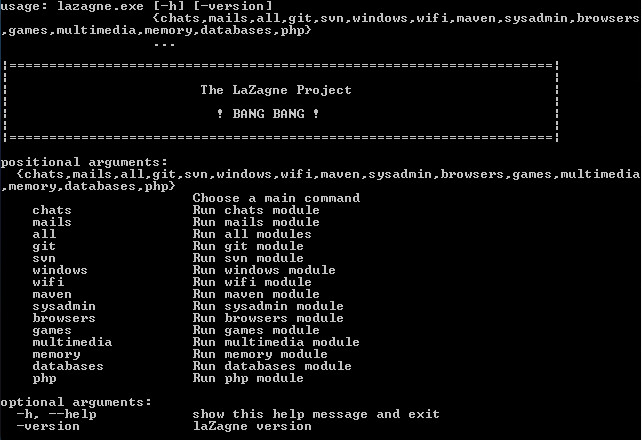HackTool.Win64.LAZAGNE.AE
HackTool:Win32/LaZagne (MICROSOFT); HackTool.Win32.LaZagne.cw (KASPERSKY)
Windows

Type de grayware:
Hacking Tool
Destructif:
Non
Chiffrement:
Non
In the wild::
Oui
Overview
It arrives on a system as a file dropped by other malware or as a file downloaded unknowingly by users when visiting malicious sites.
Détails techniques
Übertragungsdetails
It arrives on a system as a file dropped by other malware or as a file downloaded unknowingly by users when visiting malicious sites.
Datendiebstahl
Folgende Daten werden gesammelt:
- Credentials from the following software:
- Browsers:
- 7Star
- Amigo
- BlackHawk
- Brave
- Centbrowser
- Chedot
- Chrome Canary
- Chromium
- Coccoc
- Comodo Dragon
- Comodo IceDragon
- Cyberfox
- Elements Browser
- Epic Privacy Browser
- Mozilla Firefox
- Google Chrome
- Icecat
- Internet Explorer
- K-Meleon
- Kometa
- Opera
- Orbitum
- Sputnik
- UCBrowser
- Torch
- Uran
- Vivaldi
- Chat Clients:
- Pidgin
- Psi
- Skype
- Databases:
- DBVisualizer
- Postgresql
- Robomongo
- Squirrel
- SQLdeveloper
- Games:
- GalconFusion
- Kalypsomedia
- RogueTale
- Turba
- Email Software:
- Outlook
- Thunderbird
- Memory:
- Keepass
- Mimikatz Method via Pypykatz
- Multimedia:
- EyeCON
- PHP:
- Composer
- System Administration Tools:
- Apache Directory Studio
- CoreFTP
- CyberDuck
- FileZilla
- FileZilla Server
- FTPNavigator
- OpenSSH
- OpenVPN
- PuttyCM
- RDPManager
- VNC
- WinSCP
- Windows Subsystem for Linux
- Windows Software:
- Autologon
- MSCache
- Credential Files
- Credman
- DPAPI Hash
- Hashdump (LM/NT)
- LSA secret
- Vault Files
- Git for Windows
- Maven Apache
- Wifi
- Browsers:
Andere Details
Es macht Folgendes:
- It will gather credentials based on the parameter used upon execution of the application.
- It may create a txt of json file based on the parameter used upon execution of the application.
- This hacktool display the following screen for instructions:

Solutions
Step 1
Für Windows ME und XP Benutzer: Stellen Sie vor einer Suche sicher, dass die Systemwiederherstellung deaktiviert ist, damit der gesamte Computer durchsucht werden kann.
Step 2
<p> Beachten Sie, dass nicht alle Dateien, Ordner, Registrierungsschlüssel und Einträge auf Ihrem Computer installiert sind, während diese Malware / Spyware / Grayware ausgeführt wird. Dies kann auf eine unvollständige Installation oder andere Betriebssystembedingungen zurückzuführen sein. Fahren Sie mit dem nächsten Schritt fort. </ p><p> Beachten Sie, dass nicht alle Dateien, Ordner, Registrierungsschlüssel und Einträge auf Ihrem Computer installiert sind, während diese Malware / Spyware / Grayware ausgeführt wird. Dies kann auf eine unvollständige Installation oder andere Betriebssystembedingungen zurückzuführen sein. Fahren Sie mit dem nächsten Schritt fort. </ p>
Step 3
Durchsuchen Sie Ihren Computer mit Ihrem Trend Micro Produkt, und löschen Sie Dateien, die als HackTool.Win64.LAZAGNE.AE entdeckt werden. Falls die entdeckten Dateien bereits von Ihrem Trend Micro Produkt gesäubert, gelöscht oder in Quarantäne verschoben wurden, sind keine weiteren Schritte erforderlich. Dateien in Quarantäne können einfach gelöscht werden. Auf dieser Knowledge-Base-Seite finden Sie weitere Informationen.
Participez à notre enquête!
